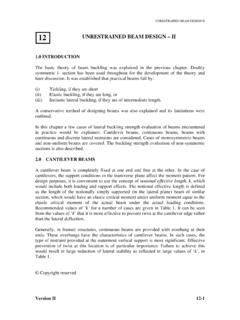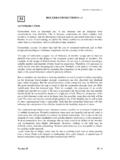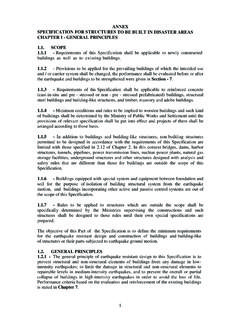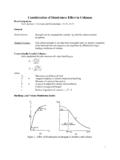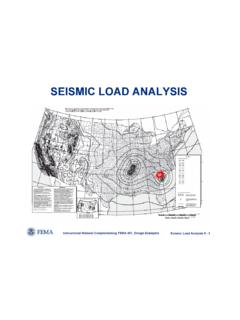Transcription of Moment Resisting Frames with Infill Panels C7
1 PART C. Moment Resisting Frames with Infill Panels C7. Document Status Version Date Purpose/ Amendment Description 1 July 2017 Initial release This version of the Guidelines is incorporated by reference in the methodology for identifying earthquake-prone buildings (the EPB methodology). Document Access This document may be downloaded from in parts: 1 Part A Assessment Objectives and Principles 2 Part B Initial Seismic Assessment 3 Part C Detailed Seismic Assessment Document Management and Key Contact This document is managed jointly by the Ministry of Business, Innovation and Employment, the Earthquake Commission, the New Zealand Society for Earthquake Engineering, the Structural Engineering Society and the New Zealand Geotechnical Society. Please go to to provide feedback or to request further information about these Guidelines.
2 Errata and other technical developments will be notified via Acknowledgements These Guidelines were prepared during the period 2014 to 2017 with extensive technical input from the following members of the Project Technical Team: Project Technical Group Chair Other Contributors Rob Jury Beca Graeme Beattie BRANZ. Dunning Thornton Task Group Leaders Alastair Cattanach Consultants Jitendra Bothara Miyamoto International Phil Clayton Beca Adane Charles Clifton University of Auckland Beca Gebreyohaness Bruce Deam MBIE. Nick Harwood Eliot Sinclair John Hare Holmes Consulting Group Weng Yuen Kam Beca Jason Ingham University of Auckland Dave McGuigan MBIE. Stuart Palmer Tonkin & Taylor Stuart Oliver Holmes Consulting Group Lou Robinson Hadley & Robinson Stefano Pampanin University of Canterbury Craig Stevenson Aurecon Project Management was provided by Deane McNulty, and editorial support provided by Ann Cunninghame and Sandy Cole.
3 Oversight to the development of these Guidelines was provided by a Project Steering Group comprising: Dave Brunsdon Kestrel Group John Hare SESOC. (Chair). Quincy Ma, Gavin Alexander NZ Geotechnical Society NZSEE. Peter Smith Stephen Cody Wellington City Council Richard Smith EQC. Jeff Farrell Whakatane District Council Mike Stannard MBIE. John Gardiner MBIE Frances Sullivan Local Government NZ. Funding for the development of these Guidelines was provided by the Ministry of Business, Innovation and Employment and the Earthquake Commission. Part C Detailed Seismic Assessment Contents C7. Moment Resisting Frames with Infill Panels .. C7-1. Contents i DATE: JULY 2017 VERSION: 1. Part C Detailed Seismic Assessment C7. Moment Resisting Frames with Infill Panels General Scope and outline of this section This section sets out the guidelines for the seismic assessment of structural steel or reinforced concrete Moment Resisting Frames with masonry Infill Panels , with or without openings.
4 Infill Panels can consist of: unreinforced clay brick masonry hollow clay brick masonry (which can be filled or unfilled, reinforced or unreinforced), or concrete block masonry (which can be solid or hollow; unfilled, partially filled or fully filled; and reinforced or unreinforced). These guidelines are valid for walls in good condition with negligible mortar joint cracking or brick splitting other than some minor damage due to settlement or similar factors which, by observation, are unlikely to be detrimental to their performance during an earthquake. The assessment procedures presented cover in-plane effects on the frame elements and the panel and also the assessment of face-loaded capacities. Note: Frames with Infill Panels have been used in New Zealand since the early 1920s. Masonry Infill Panels modify the seismic response of the adjacent frame elements in terms of stiffness, the nature of the applied loads and local ductility demands.
5 Many of the behaviour issues associated with Frames with Infill Panels arise from discontinuities of Infill , resulting in soft storeys or non-uniform distribution of storey stiffness. This in turn leads to a high concentration of seismic loading to be transferred amongst the associated elements. Consequently, if Infill Panels are present in a building, it is important that their influence on its seismic performance is explicitly considered. Useful publications Useful information on materials, inspection and assessment of Infill Frames is contained in: ASCE 41-13 (2014). Seismic evaluation of existing buildings, American Society of Civil Engineers and Structural Engineering Institute, Reston, Virginia, USA. FEMA 306 (1998). Evaluation of earthquake damaged concrete and masonry wall buildings Basic Procedures Manual, Applied Technology Council, Redwood City, California.
6 Flanagan, and Bennett, (1999). Arching of masonry infilled Frames : comparison of analytical methods, ASCE Practice Periodical on Structural Design and Construction, 4(3), 105-110. Flanagan, and Bennett, (2001). In-plane analysis of masonry Infill Panels , Practice Periodical on Structural Design and Construction, American Society of Civil Engineers, Reston, Virginia. MSJC (2011). TMS 402-11: Building code requirements for masonry structures, Masonry Joint Standards Committee, Reston, Virginia. C7: Moment Resisting Frames with Infill Panels C7-1. DATE: JULY 2017 VERSION: 1. Part C Detailed Seismic Assessment Stavridis, A. (2009). Analytical and experimental study of seismic performance of reinforced concrete Frames with masonry walls, PHD Dissertation, University of California, San Diego. Turgay, T., Durmus, , Binici, B. and Ozcebe, G.
7 (2014). Evaluation of the predictive models for stiffness, strength and deformation capacity of RC Frames with masonry Infill walls, ASCE Journal of Structural Engineering, 06014003, 1-9. Definitions and acronyms Action Set of concentrated or distributed forces acting on a structure (direct action), or deformation imposed on a structure or constrained within it (indirect action). The term load' is also often used to describe direct actions. Beam A member subjected primarily to loads producing flexure and shear Column A member subjected to loads producing flexure shear and axial actions Dead load The weight of the building materials that make up a building, including its structure, enclosure and architectural finishes. The dead load is supported by the structure (walls, floors and roof). Ductile/ductility Describes the ability of a structure to sustain its load-carrying capacity and dissipate energy when it is subjected to cyclic inelastic displacements during an earthquake Face-loaded walls Walls subjected to out-of-plane inertial forces.
8 Also see Out-of-plane load. Gravity load The load applied in a vertical direction, including the weight of building materials (dead load), environmental loads such as snow, and building contents (live load). Infill panel A panel of masonry bounded by beams and columns and constructed partially or fully within the plane of a steel or reinforced concrete frame Infill wall See Infill panel In-plane load Load acting along the wall length Irregular building A building that has an irregularity that could potentially affect the way in which it responds to earthquake shaking. A building that has a sudden change in its plan shape is considered to have a horizontal irregularity. A building that changes shape up its height (such as one with setbacks or overhangs) or that is missing significant load-bearing elements is considered to have a vertical irregularity.
9 Structural irregularity is as defined in NZS :2004. Lateral load Load acting in the horizontal direction, which can be due to wind or earthquake effects Load See Action Masonry Any construction in units of clay, stone or concrete laid to a bond and joined together with mortar Moment Resisting A building frame system in which lateral loads are resisted by shear and flexure in frame (MRF) members and joints of the frame Mortar The cement/lime/sand mix in which masonry units are bedded Out-of-plane load Load acting at right angles to the wall surface. Walls subjected to out-of-plane shaking are referred to as face-loaded walls. Soft storey A level (storey) in a multi-storey building which is weaker than the levels above Wythe A continuous vertical section of masonry one unit in thickness. A wythe may be independent of, or interlocked with , the adjoining wythe(s).
10 C7: Moment Resisting Frames with Infill Panels C7-2. DATE: JULY 2017 VERSION: 1. Part C Detailed Seismic Assessment Notation, symbols and abbreviations Unless otherwise stated, the notation in this section has the following meanings: Symbol Meaning Width of equivalent diagonal compression strut op Area of the opening in an Infill panel wtot Gross area of an equivalent Infill panel with no openings Residual strength ratio i p Part spectral shape coefficient from NZS :2004. Refer to Section C3. Effective member depth to the centroid of the tension reinforcing steel ' Effective member depth to the centroid of the compression reinforcing steel bb Probable moduli of elasticity of the bounding beam bc Probable moduli of elasticity of the bounding column f Probable modulus of elasticity of frame material m Probable modulus of elasticity of Infill material m Probable masonry compressive strength ph Seismic out-of-plane demands on masonry Infill walls y Probable yield strength of reinforcement col Column height between centre lines of beam inf Height of Infill panel bb Moment of inertia in the plane of the Infill for the bounding beam bc Moment of inertia in the plane of the Infill for the bounding column d Internal lever arm Empirical constant ini Uncracked stiffness of perforated Infill panel solid ini Stiffness of
